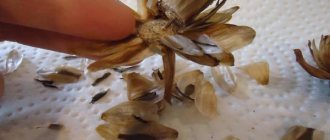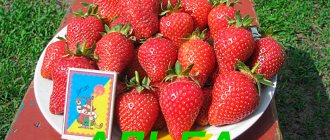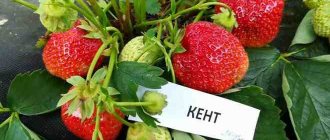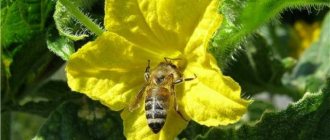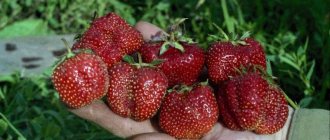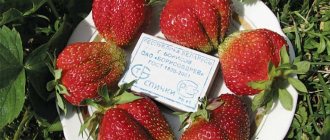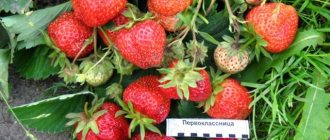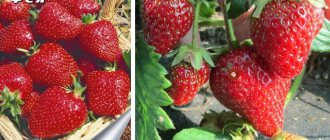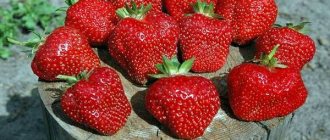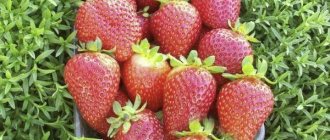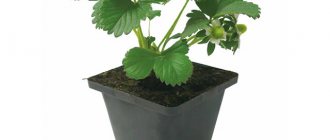At the end of the last century, Dutch breeders developed a non-repairing strawberry variety, Figaro. Due to capriciousness or poor adaptability to cold Russian winters, this berry never found wide popularity among farmers and gardeners. However, reviews on online forums about the large fruits and attractive taste characteristics of the variety still excite the imagination.
The average size of the Figaro berry is 30-60% higher than that of the Elsanta variety, popular among gardeners, but the yield is 20% lower
Description of the variety
It is difficult to say the exact ripening time of Figaro, since in warm regions this strawberry begins the season along with mid-season varieties, and in cold regions it catches up with late ones.
The variety is intended for open ground. It can also be grown under film, but not for early production. In general, Figaro is optimally suited to the mild climate of central Europe.
Bushes
The plant has powerful, erect, pubescent stems and large light green leaves. Peduncles rise above the foliage and produce 5-8 flowers. The number of peduncles is small, branching is moderate. The flower stalks bend under the weight of the fruit. The variety produces very few mustaches.
A characteristic feature of the Figaro variety: the presence of several 4- and 5-legged leaves, while most of the foliage is “three-legged.”
Berries
The first berries are very large, conical or wedge-shaped. The number of deformed fruits is small. The skin is shiny, orange-red, the variety is not prone to darkening of the berries. Starting from the middle of the season, the berries become smaller, so the average weight at the end of the year is 20 g. With insufficient care, the plant even becomes small-fruited.
The pink-red flesh is moderately firm, fleshy and very aromatic. Reviews about the taste characteristics vary greatly. There are several explanations for this - incorrect agricultural technology, different climatic conditions, or the variety does not have ideal consumer qualities.
Figaro berries are suitable for thermal processing and deep freezing, and tolerate transportation well
Productivity
Figaro reveals its productivity potential in the second year of fruiting. In terms of this indicator, it is difficult for many mid-season varieties to keep up with it. Up to 700 g of berries ripen on one bush.
Characteristics of berries
The surface of the fruit is colored juicy red-orange, and the flesh is pink. Their weight starts from 20 grams. Berries can be eaten not only fresh, but also frozen, used to make jam, marmalade or various types of drinks.
Strawberries are characterized by increased hardness. This is of great importance for fruit transportation and storage:
- cone-shaped;
- with glossy surface;
- with thick skin.
The first fruits are a slightly ribbed product. The subsequent ones usually have a beautiful shape. The average weight is significantly greater than that of other off-season varieties. Small strawberries are rare at the end of harvest. Fruits ripened in sunny weather have a good taste.
Important. When strawberries ripen during the rainy season, a white neck sometimes forms.
The large size makes collecting them easier. Strawberries are also very easy to sort. The size of the berries does not decrease when grown for 5 years.
a brief description of
Advantages of the variety
Despite conflicting reviews, Figaro strawberries have a number of advantages:
- the fruits are beautiful, fragrant;
- high productivity;
- low percentage of deformed berries;
- immunity to fungal infections;
- suitability for transportation;
- ability to be stored for a long time;
- practically no chlorositis.
Disadvantages of the variety
For commercial purposes, the variety falls short in many respects:
- poor wintering, requires shelter in the middle zone;
- difficulties with reproduction, few whiskers;
- heat and drought resistance are below average;
- does not tolerate return frosts;
- tendency to small fruits if agricultural practices are not followed;
- low resistance to verticillium and heart rot.
Thus, the variety is difficult to grow both in the southern regions and in areas with very cold winters. This strawberry needs a mild climate without sudden drops in temperature.
The best varieties of strawberries: description and photo on Supersadovnik.ru
The Poisk agricultural company has extensive experience in testing garden strawberries. The company has been doing this for many years; today there are more than 120 varieties in its assortment - and these are only those that have successfully passed tests and been approved. Do you want to know which varieties of garden strawberries made the greatest impression on the agronomists of the agricultural company?
Garden strawberry variety Vima Zanta
The Vima Zanta variety is an unpretentious variety, one of the most frost-resistant. It begins to bear fruit very early, already in early June. Practically not susceptible to verticillium and powdery mildew. The berries are large, up to 40 g, beautifully shaped, sweet, juicy and strong - suitable for homemade preparations.
Garden strawberry variety Vima Zanta
Garden strawberry variety Deroyal
The berries are sweet, shiny, weighing up to 50 g. They are not suitable for long-distance transportation, but they have an excellent taste and a strong pleasant aroma, and they are evenly distributed: even in the last harvest there are very few small berries. The Deroyal variety is little susceptible to diseases.
Garden strawberry variety Deroyal
Garden strawberry variety Camarosa
The berries are excellent in quality: beautiful, dense, transportable, but at the same time very sweet. Resistant to gray rot. The Camarosa variety is quite unpretentious, and with good care it is very productive. It forms a small amount of whiskers, so it is easy to care for.
Garden strawberry variety Camarosa
Garden strawberry variety Kent
The Kent variety is winter-hardy, resistant to powdery mildew and gray rot. Compared to other varieties, the flowers tolerate frost well. The berries are beautiful, dense and sweet even when ripening in cloudy weather. They store well and do not wrinkle during transportation.
Garden strawberry variety Kent
Garden strawberry variety Kimberly
The berries are large, up to 50 g, heart-shaped, dense and weighty, without voids in the middle. The taste is very sweet, “caramel” is one of the most sugary varieties. It is distinguished by high winter hardiness and resistance to powdery mildew, however, the Kimberly variety forms a lot of mustaches.
Garden strawberry variety Kimberly
Garden strawberry variety Lambada
The fruits are tender, with a strong aroma, uniform in size. The bush is vigorous, with strong peduncles, open - easy to pick berries. The Lambada variety is resistant to Verticillium wilt and gray rot, and tolerates compacted planting.
Garden strawberry variety Lambada
Garden strawberry variety Korona
With good care, it is one of the most productive varieties. The berries are medium to large, 30 g, distinguished by a rich red color and a regular conical shape, sweet, quite aromatic, resistant to gray rot, but with a delicate skin. The Corona variety produces a lot of mustache.
Garden strawberry variety Korona
Garden strawberry variety Polka
The first berries are large: up to 60 g; from later harvests - smaller ones. The fruits are dark red, very tasty and aromatic. The leaves are large, resistant to powdery mildew, and the bush forms many tendrils. The winter hardiness of the Polka variety is average - it can freeze out in snowless frosts.
Garden strawberry variety Polka
Garden strawberry variety Suzy
The winter hardiness of the variety is high. The fruits are medium in size, smooth, dense, sweet with a pleasant sourness and light aroma, scarlet in color, good fresh and for processing. Well kept. The winter hardiness of the Suzy variety is quite high.
Garden strawberry variety Suzy
Garden strawberry variety Tago
The Tago variety is distinguished by its excellent fruit taste and consistently high yield. The berries are very large (up to 70 g), red, the pulp is well colored, dark, sweet - the fruits make very beautiful jams and compotes. They ripen in early July. Winter hardiness is high.
Garden strawberry variety Tago
Garden strawberry variety Figaro
The berries are large, very dense, with an orange tint to the skin and delicate pink pulp. Their long stalks make them very easy to pick. The yield of the Figaro variety is one of the highest; it is resistant to diseases of the root system and gray rot.
Garden strawberry variety Figaro
Garden strawberry variety Bohemia
The Boheme variety is drought-resistant and winter-hardy, does not suffer from spring frosts, is not picky about the soil and succeeds in different climatic conditions. The berries are large, dark, with shiny, dense skin, and are excellently stored. The pulp is dense, excellent taste and aroma.
Garden strawberry variety Bohemia
Garden strawberry variety Vima Tarda
The fruits are large, up to 45 g, cone-shaped, shiny and dense, intended for dessert. The variety is one of the last to ripen; the berries are hidden under the leaves and are hardly noticeable to birds. The Vima Tarda variety is winter-hardy, resistant to gray rot, powdery mildew, and strawberry mite.
Garden strawberry variety Vima Tarda
Garden strawberry variety Symphony
The Symphony variety is winter-hardy, resistant to gray rot and verticillium wilt, and is slightly affected by spotting. The berries are large, bright red, with colored pulp, sweet and aromatic. They separate well from the stalk.
Garden strawberry variety Symphony
Garden strawberry variety Maxim (Gigantella Maxim)
Mid-season variety Maxim (Gigantella Maxim). A powerful plant with strong peduncles, it requires intensive care and frequent watering - with a lack of moisture, the size of the berries decreases. The first berries are very large (up to 110–125 g), sweet, with loose pulp and a light aroma. The berries from the last harvest are smaller.
Garden strawberry variety Maxim (Gigantella Maxim)
Garden strawberry variety Mize Schindler
Old variety. Despite the fruits being small by modern standards, they are still popular due to their amazing taste - one of the best among dessert varieties. In appearance it resembles a raspberry. The Mize Schindler variety is quite resistant to verticillium, powdery mildew, and mites. The ripening period is late.
Garden strawberry variety Mize Schindler
Garden strawberry variety Mara des Bois (Mara de Bois)
Unusual, recognizable taste and aroma of berries - with a hint of wild strawberries. Remontant variety Mara des Bois (Mara de bois), bears fruit continuously. The largest berries are produced from the first and last pickings; in mid-summer they usually become smaller. Can bear fruit on rosettes of the current year (suitable for growing on a trellis).
Garden strawberry variety Mara des Bois
Garden strawberries Pineberry and Anablanca varieties
Pineberry and Anablanca varieties with small but numerous white berries. The color of the pulp ranges from white to orange. Ripe berries are almost completely white (pinkish in bright areas), but with red seeds and a strong pineapple aroma.
Varieties of garden strawberries (strawberries) of neutral day
Such varieties bear fruit from June to autumn almost continuously, and not in waves, like ordinary remontant varieties.
Garden strawberry variety Florin
With good care, it produces up to 1000 g of berries per bush. Resistant to weather fluctuations, including drought. The berries of the Florin variety are light red, the flesh is pink. Peduncles rise above the leaves.
Garden strawberry variety Florin
Garden strawberry variety Evi 2
The Evi 2 variety bears fruit throughout the season without changing the size of the berries. The fruits are perhaps the most delicious among the day neutral varieties. Looks good and grows well in containers.
Garden strawberry variety Evi 2
Garden strawberry variety Evis Delight
A very productive variety (up to 3 kg of berries per bush for the summer). Large (up to 20 g) berries of uniform size, sweet, aromatic and with thick skin (well stored).
Garden strawberry variety Evis Delight
Garden strawberry variety Sweet Evi
Compared to other remontant varieties, the Sweet Evi variety is unpretentious to soil conditions. The berries are large, sweet, and high in vitamin C.
Garden strawberry variety Sweet Evi
Consider the potential of your hard work
A couple of feedings a year and watering in dry weather - with such care it is better to limit yourself to ordinary varieties that bear fruit once, but almost certainly.
Remontant varieties of large-fruited strawberries bear fruit from June until autumn frosts, but they need to be fed every 2-3 weeks with liquid organic fertilizer.
Such varieties are also more demanding when it comes to watering; if you care for them “lazyly,” they will be of no use.
Select varieties with different ripening periods
If you grow mainly varieties with a single fruiting, it is better that among them there are early, mid-ripening, and late ones. This will allow you to stretch out the harvest for more than a month.
The collection should be based on resistant varieties
Dark green shiny leaves are usually a sign of the variety’s resistance to a number of diseases. Such foliage is less affected by mites, spotting and powdery mildew. On strong peduncles located at the foliage level or higher, berries are less affected by gray rot. Pay attention to these signs when reading descriptions or choosing strawberry seedlings at the garden center.
Taste is more important, not picture
Farmers prefer garden strawberries with brightly colored, beautiful, strong berries, and for the amateur garden, we advise you to buy the most delicious and aromatic ones - these are the varieties we chose for review.
Skip to main article about strawberries
We thank Tatyana Guseva, scientific agronomist at the Poisk agricultural firm, for her help in preparing the material.
Source: https://www.supersadovnik.ru/text/luchshaya-klubnika-1004171
Landing
It is preferable to plant Figaro strawberries in August so that the seedlings have time to take root and develop before frost. In spring, planting is done after the threat of return frosts has passed.
To get good harvests, you need to follow the rules for preparing the bed:
- the site is dug up to a depth of at least 30 cm;
- At the same time, fertilizers are added to the soil (a bucket of manure or compost per 1 square meter);
- lime or dolomite flour is added to acidified soil; dolomite flour is preferable because additionally enriches acidic soils with magnesium;
- clear the ground of rhizomes and weeds;
- the bed is loosened and leveled.
For summer-autumn planting, the bed is prepared in 2-3 weeks, for spring planting - in the fall. The distance between plants is left at least 20 cm, between rows - 40-50 cm. Root up to the root collar in pre-moistened soil. After planting, the plant is watered abundantly and mulched.
Optimal strawberry predecessors: beans, peas, carrots, parsley, dill
Strawberry Figaro - a new competitor on the berry Olympus
The early strawberry variety Figaro is the result of the work of Dutch breeders, and there is still no clear opinion about this variety.
Supporters extol its taste, the size of the berries and their portability, while opponents trumpet the capricious nature of the culture and poor immunity to the varied Russian climate.
The article gives the characteristics of the variety, features of planting and care, as well as an analysis of the positive and negative aspects of the crop.
Characteristics of the variety, its advantages and disadvantages
The plant itself is a powerful bush with large light green leaves. The berries are red-orange with pink flesh and good taste. They reach a weight of 20 g, are characterized by resistance to deformation and good transportability, and are suitable for various shapes of workpieces. However, if the bushes are not properly cared for, then over time the berries become smaller.
This variety is mid-season, intended for cultivation in open ground. Although it is noted that it is also suitable for greenhouses, the harvest will not be early. Figaro loves sunny places with light to medium soils. Resistant to mild frosts.
Gardeners should not be afraid of a low yield in the first year of fruiting - Figaro will show its maximum in the 2nd year. It is noted that the variety produces slightly less than 1 kg of berries from one bush. Figaro is often compared to the Elsanta variety. The results are ambiguous: Figaro has almost half the berries, but Elsanta has higher yield stability.
The advantages of Figaro include:
- fruit size, their aesthetic and taste qualities;
- frost resistance;
- good keeping quality and transportability;
The disadvantages include:
- unstable yield;
- the exactingness and capriciousness of strawberries in compliance with agricultural technology;
- low vegetation potential.
Landing
Although the Figaro variety can be planted from April to October, it is preferable to plant in late August or early September so that the plants have time to take root and become stronger. When choosing a place to place beds with strawberries, you should take into account that the best predecessors are garlic, onions, mustard, radishes, and peas.
The area intended for planting strawberries is dug up to a depth of at least 30 cm, thoroughly cleared of rhizomes and weeds, and fertilizers, most often manure, are applied.
The site must be prepared 3 weeks before planting: dug up, cleaned, added manure, leveled, and left to rest. Next, prepare the wells.
They are located in a row at a distance of 20-30 cm from each other, the distance between rows is 50-70 cm.
After planting, the strawberries should be watered well, and an hour after watering, loosen the soil around them. Watering regime is a very important point in the process of cultivating this variety of strawberries. The first two weeks it must be done strictly in the morning and evening.
Since strawberries are very demanding on agricultural technology, violation of these rules will lead to a decrease in yield.
Care
The set of measures for caring for plants of this variety does not require anything special and consists of traditional operations for caring for strawberries:
- Weed control and weeding. Weeds take up plant resources and contribute to dampness, which can cause various diseases. Therefore, you need to get rid of them as they arise. Weeding and loosening provide air access to the roots. This allows for improved absorption of nutrients from the soil.
- Hilling - once a season. To strengthen the bush and increase the growth of green mass, it is recommended to hill it at the end of June.
- Watering. During the period of flowering and ripening of berries, strawberries need daily abundant watering. On hot days, watering is carried out before sunrise and after sunset.
- Update. After fruiting has ended, the old leaves should be trimmed without touching the core. After this, weed and feed the strawberries. It is necessary to trim the leaves again before preparing for wintering. This simple technique will increase productivity and prevent Figaro from degenerating.
- Feeding. Strawberries traditionally prefer a combination of organic and mineral fertilizers. The first include manure and wood ash, which are scattered between the rows during flowering to increase the number of buds and fruits (it is important to remember that the presence of burnt plastic and metals in the ash is unacceptable!). The second group includes Agricola, which is used throughout the growing season, and Azofoska, which is used traditionally before the start of strawberry flowering, when the soil has warmed up well. A reasonable balance of organic and mineral fertilizers should be maintained. Excess of them will not benefit strawberries. Traditionally, Figaro is fed 4 times.
Top dressing
1 In the spring, immediately after the snow melts Agricola 2 Before flowering Azofoska 3 During the period of berry formation Manure and wood ash
4 In mid-August Agricola and ash
Pest Control
Figaro is considered a disease-resistant variety. In any case, the root system is the strong point of the plant and is resistant to powdery mildew.
But the weak point of Figaro is the rotting of the heart and fungal infection by verticillium. These are mushrooms whose mycelium releases substances that are toxic to strawberries and causes the plant to wither. The disease is called verticillosis.
Its main symptom is dried lower leaves. Over time, the berries rot, then the bush dies off entirely. The main danger of this disease is that strawberries can be affected for a long time, and the active consequences appear after 2-3 years.
The best fight against disease is its prevention. In the case of strawberries, this means a competent choice of planting site, constant removal of weeds, as well as replanting Figaro every 3-4 years, as well as constant presence next to the garlic beds.
It is a natural fungicide and disinfects the soil and air.
Another element of prevention is compliance with crop rotation and crop precedence rules. The risk of infecting strawberries becomes higher if they are planted in a place where beets, nightshades and cucumbers previously grew.
If damage does occur, the plant must be removed and disposed of. It should not be added to compost or burned to avoid the risk of reintroducing spores into the soil. Next, you need to cultivate the soil in place and around this bush.
For processing, “Fitosporin”, “Bordeaux mixture”, “Maxim” and others are used. Spraying and watering are carried out on cloudy days; it is advisable that after treatment there is no rain for at least 24 hours.
Reproduction
Figaro is propagated in two ways: seeds and mustaches. The first method is considered more difficult. You can get seeds from a healthy ripe fruit. You need to cut off the skin with the seeds and leave it to dry. After this, the skin must be ground, the seeds separated and stored at a temperature of 0-2 degrees.
Before germination, seeds must be pickled in a weak solution of potassium permanganate. This is done to disinfect and increase the immunity of plants.
Seeds saturated with water are placed on the prepared soil, spread over the surface with a toothpick and covered with film. As soon as the shoots appear, the film is removed and cared for as for ordinary seedlings.
After two true leaves appear, the seedlings are picked and placed in peat pots, and from there they are then planted in open ground.
During the growing season, strawberries grow mustaches, at the ends of which a rosette of a daughter bush is formed. Figaro produces few whiskers compared to other varieties, but they still exist.
This is a simpler and more effective method, since we are dealing with a more mature and strong plant that receives nutrition from the mother bush. The best are considered to be 1st and 2nd order sockets.
If the bush produces a long tendril with more rosettes, then they should be pinched.
Having chosen a suitable sample for rooting, it is pinned to the ground, or planted in a pot and watered. When the strawberries take root, cut them off. If propagation is not part of the gardener’s plans for this year, then the tendrils simply need to be trimmed so that the mother plant does not waste resources on them. Strawberries no younger than 4 years old are chosen as mother strawberries.
Preparing for winter
Preparations for the rest period begin in August:
- cut off old leaves. But under no circumstances should they be left in the beds and aisles;
- remove diseased plants and replace them with young ones;
- fertilize with complex fertilizers. To prevent the roots from getting burned, fertilizers are applied only to moist soil;
- mulch with a thick layer of compost or humus;
- limit nitrogen fertilizers to prevent the growth of green mass;
- treated with insecticides against pests;
- if August and September are dry, then the beds are watered once a week
- at the end of October-beginning of November, when frosts begin, the strawberries are covered with a double layer of agrofibre; if the winters are not severe, then with one. Condensation does not accumulate under it, it protects well, and is not dangerous in case of recurrent frosts.
- In the spring, the shelter is removed during the first thaw, otherwise the bushes will rot.
Figaro is a rather controversial variety of garden strawberry with excellent taste and marketing properties. However, fierce competition among other varieties, a scrupulous requirement for observing all the subtleties of care and a tendency to fungal infections do not make it popular among gardeners. Although high yields and tasty fruits give hope that Figaro will find its niche among strawberry varieties.
Strawberry Figaro - a new competitor on the berry Olympus Link to main publication
Source: https://VashaKlubnika.ru/sort/klubnika-figaro
Growing and care
In agricultural technology, Figaro is standard, requires basic care, but, depending on climatic conditions, behaves unpredictably.
Watering
The yield depends on compliance with the irrigation regime. Soil humidity during flowering and ripening of berries on sandy soils should be at least 70%. Adjustments are made taking into account climate conditions. For the first 15 days after planting, strawberries are watered abundantly and daily.
The roots of an adult strawberry bush are located at a depth of 12-15 cm; when watering, the soil should be wetted to the specified depth.
The optimal method of watering is drip irrigation. This is a simple system that can be purchased ready-made or made independently by laying hoses with holes along the beds
Loosening, weed control
Strawberries don't like being around weeds. The beds are weeded as they grow, at least 2 times a month. To ensure that the plant’s roots have access to oxygen, the soil is regularly loosened to a depth of no more than 4 cm.
Sometimes, to strengthen the plant, hilling is required, after which the bushes become lush and the harvest is more productive.
Removing a mustache
The Figaro garden strawberry does not produce a lot of whiskers; the excess ones are removed in a timely manner. Otherwise, they will take away growth energy from the mother bushes.
Top dressing
To ensure adequate nutrition for the plant, it is necessary to alternate organic and mineral fertilizers:
- In early spring, a solution of cow manure is used. 0.5 liters of fertilizer per plant, at a concentration of 1:10.
- Before flowering begins, use Azofoska according to the instructions. It contains nitrogen, phosphorus and potassium.
- At any stage of growth, you can feed plants by leaf or root with Agricola. The drug provides the plant with all the necessary microelements.
In the fall, wood ash will be a good fertilizer, which can be applied in an aqueous solution or scattered between the bushes before watering.
Pest and disease control
The Figaro variety is resistant to diseases of the root system, gray rot, is weakly affected by powdery mildew, but has very weak immunity to heart rot and verticillium. As a preventative measure, in early spring the beds are treated with a 1% solution of Bordeaux mixture. To prevent strawberries from getting sick, you need to make sure that the soil is not over-moistened and that the bed is not overgrown with weeds.
An excellent natural “fungicide” is garlic planted between the bushes. The only thing is that onions, garlic, and beets can cause an outbreak of nematodes, so if the pest has manifested itself before, you should not plant garlic. Most pests will be repelled by tobacco powder scattered over the garden bed.
Preparing for winter
In the fall, preparing strawberry bushes for winter, they carry out standard activities:
- remove old and diseased leaves;
- if necessary, thin out the beds;
- from insects they are treated with insecticides;
- mulch and cover the bushes with agrofibre.
In spring, the shelter is removed during the first thaw, otherwise the bushes will rot.
Protection from diseases and pests
The variety is resistant to root damage and gray rot. It is slightly affected by powdery mildew. At the same time, the crop is susceptible to heart rot and verticillium. To prevent planting, it is worth spraying with 1% Bordeaux mixture. This is done in early spring. To avoid pathologies, it is important to ensure that the soil is not waterlogged. It is recommended to remove weeds in a timely manner.
Garlic has pronounced fungicidal properties. It needs to be planted between bushes. It is important to take into account that garlic, onions and beets can provoke an outbreak of nematode attacks. If these parasites were previously noticed, you should not plant such plants. Many insects are repelled by tobacco powder, which needs to be scattered over the garden bed.
Reproduction
Figaro is bred by seeds or by dividing the bush. The most difficult thing to propagate is from seeds:
- On fully ripened fruits, cut off the skin and leave it to dry.
- Rub in your palms, separating the seeds.
- Before planting, soak in a weak solution of manganese.
- The seed material soaked in water is laid out on universal earthen soil (do not fall asleep!).
- Cover the planting box with glass or polyethylene.
- When the first two leaves appear, a pick is made.
- Then proceed as with ordinary seedlings.
The easiest way to propagate Figaro is with a mustache. The mustache rosettes of the first and second order are considered the strongest. They can be immediately rooted in plastic pots. Transplantation to a permanent place is carried out 3-4 days after cutting off from the mother bush.
For division, bushes 3-4 years old are selected. Strawberries are propagated by dividing the bush in early spring or late summer, when the heat subsides.
Care and feeding
Caring for strawberries includes a set of activities. They include:
- Weeding. The plant does not like being around weeds. The beds are weeded as they grow and at least 6-8 times per season. Along with weeding, the mustache is trimmed.
- Loosening the soil. The roots of the plant must have access to oxygen. The soil is loosened 3 times before the strawberries begin to bloom and once every 2 weeks. The depth of soil loosening should be 3-4 cm.
- Hilling. This is done to strengthen the plant. With high-quality hilling of the plant, its bushes become lush and yields increase.
- Watering. The soil in beds with strawberries must be moistened to a depth of at least 30 cm. During watering, the row spacing is filled with water.
Depending on the stage of plant growth, it is fed with various types of fertilizer. Before winter, strawberries are insulated. For this you can use film or foliage. To ensure proper nutrition of the plant, when feeding it, alternate organic and mineral fertilizers.
Among the most common mineral fertilizers:
- Azofoska. Contains nitrogen, phosphorus and potassium.
- Stimovit. Used for pest control.
- Agricola. The plant is fed with this type of fertilizer at all stages of growth.
Among the most commonly used organic fertilizers by gardeners for feeding strawberries is compost and manure.
Reviews
I planted Figaro in April of this year. It was very surprising that the barely alive bushes, which had not even had time to grow leaves, had already produced flower stalks. The berries are dense, large, sweet and sour. In the first year, each bush had one peduncle; on some bushes I removed them, but I can’t say that this led to increased foliage growth. I'll keep watching.
My Figaro is severely affected by spider mites. Scalding the bushes with hot water helped. I heat the water to 80-85 degrees. and pour out 100-150 ml. on the bush.
Garden strawberries of the Figaro variety are suitable for growing in summer cottages and garden plots. It is not used for commercial purposes, as it has more productive and powerful competitors.
Strawberry variety Figaro
Figaro is a mid-season non-repairing variety of garden strawberries (strawberries) for universal use. It was developed in the Netherlands in the late 90s, did not gain widespread popularity and went unnoticed by most farmers and gardeners. The plant has good winter hardiness, so it can be grown in rather cold regions of Russia. The variety is suitable for cultivation in a summer cottage; it is not currently used for commercial purposes, losing out to modern new products in all characteristics.
The plant is powerful and erect. The leaves are light green in color. The flowers are white, bisexual. The peduncles are long, strong, tall, located above the level of the leaves, and tend to lie on the ground under the weight of the crop. The berries are medium and large in size, conical in shape. The skin is orange-red, shiny. The flesh is pink, dense but not hard, with a pleasant consistency, aromatic.
The taste of the variety is not bad, although gardeners did not appreciate it very well. In this case, there are two possible reasons for dissatisfaction - either errors in agricultural technology or the climatic conditions of the region did not allow strawberries to acquire a full palette of taste, or Figaro itself does not shine with outstanding consumer qualities. And, to be honest, gardeners are more inclined to the second option. The fruits are universal in use, suitable for processing, fresh consumption and freezing. The berries tolerate transportation well and have a fairly good presentation, but we will not talk about commercial cultivation of this variety.
The average weight of berries in a season is approximately 20 grams, although gardeners note that Figaro suffers from small fruits. In general, it is declared as high-yielding, and not just, but “one of the highest yielding.” To be honest, this statement bears little resemblance to the truth. This variety cannot be compared with the generally recognized favorites of the strawberry market, and gardeners confirm this. And given that it is not used in commercial cultivation, we can conclude that it really does not have outstanding yield potential. It is very difficult to give specific figures, there is very little information, so let’s not make things up and say this - our hero will not please you with productivity. If you need a high-yielding variety, take a closer look at the popular “giants” of the strawberry market.
Strawberries are resistant to diseases of the root system and gray rot, and moderately susceptible to powdery mildew. The variety's winter hardiness is quite good; it can be successfully grown in rather cold regions, but a mild climate without extremely low temperatures in winter is still preferable. Figaro's heat and drought resistance are low; in hot southern regions its cultivation will be extremely problematic.
In terms of agricultural technology, our hero is quite standard, requiring only basic care, but not everything is so simple. The fact is that plants behave differently in different climatic conditions. So, in the southern regions you will have to fight for the harvest, as well as in very cold ones. By the way, there is some confusion with the ripening period of the variety - in warm regions it begins the season on a par with mid-ripening ones, in cold regions it catches up with late ones. If we summarize the reviews of gardeners, we can say the following: either gardeners could not find the “key” to this strawberry, or it is too capricious, or it does not have much potential, and therefore does not live up to expectations both in terms of yield and taste.
Figaro is a very controversial variety that has failed to win the trust of either farmers or summer residents. What’s wrong with it, and why does advertising scream one thing, but in reality it turns out something else? To be honest, answering this question is quite difficult. Overall, these strawberries can really disappoint you, so before you buy, look at a few more options and choose the best one.

